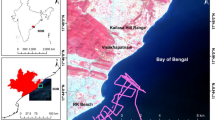Abstract
The coastal zone of the Sagar island has been studied. The island has been subjected to erosion by natural processes and to a little extent by anthropogenic activities over a long period. Major landforms identified in the coastal area of the Sagar island are the mud flats/salt marshes, sandy beaches/dunes and mangroves. The foreshore sediments are characterized by silty, slightly sandy mud, slightly silty sand and silty sand. Samples 500 m inland from high waterline are silty slightly sandy mud, and by clayey slightly sandy mud. The extent of coastline changes are made by comparing the topographic maps of 1967 and satellite imageries of 1996, 1998 and 1999. Between 1967 and 1999 about 29.8 km2 of the island has been eroded and the accreted area is only 6.03 km2. Between 1996 and 1998 the area underwent erosion of 13.64 km2 while accretion was 0.48 km2. From 1998 to 1999, 3.26 km2 additional area was eroded with meager accretion. Erosion from 1997 to 1999 was estimated at 0.74 km2 /year; however, from 1996 to 1999, the erosion rate was calculated as 5.47 km2/year. The areas severely affected by erosion are the northeastern, southwestern and southeastern faces of the island. As a consequence of coastal erosion, the mud flats/salt marshes, sandy beaches/dunes and mangroves have been eroded considerably. Deposition is experienced mainly on the western and southern part of the island. The island is built primarily by silt and clay, which can more easily be eroded by the waves, tides and cyclonic activities than a sandy coast. Historic sea level rises accompanied by land subsidence lead to differing rates of erosion at several pockets, thus periodically establishing new erosion planes.









Similar content being viewed by others
References
Allison MA 1998 Historical changes Ganges-Brahmaputra delta front J Coast Res 14: 1269–1275
Allison MA, Khan SR, Goodbred SL Jr, Kuel SA 2003 Stratigraphic evolution of the Holocene Ganges--Brahmaputra lower delta plain Sediment Geol 155: 317–342
Baksi A, Hazra S, Sen G, Mukherjee AD 2001 Estimation of relative sea level rise from Tide Gauge data of Sagar island of Bay of Bengal J Coast Res
Bandopadhyay S (2000) Sagardwip: some environmental problems and men. In: Bomkesh Maity (ed) Bish Sataker Sagardwip (20th Century Sagar Island), Quarterly April – June
Chen J 1997 The impact of sea level rise on China’s coastal areas and its disaster hazard evaluation J Coast Res 13(3): 925–930
Colemann JM 1969 Brahmaputra River: channel process and sedimentation Sediment Geol 3: 29–239
Das G 2000 History of Sagardwip: 1815–1915. In: Bomkesh Maity (ed) Bish Sataker Sagardwip (20th Century Sagar Island) Quarterly, April – June
Davies JL 1964 A morphogenic approach to world shorelines Zeits Geomorphol 6: 27–42
Emery EO, Aubrey DG 1989 Tide gauge of India J Coast Res 5: 489–501
Flemming BW 2000 A revised textural classification of gravel-free muddy sediments on the basis of ternary diagrams Contin Shelf Res 20: 1125–1137
Ghosh T, Gopinath B, Sugata H (2001) Assessment of landuse/landcover dynamics and shoreline changes of Sagar island through remote sensing. 22nd Asian conference on Remote sensing, 5–9 November, 2001, Singapore
Indian Metrological Department (1964) Tracks of storms and depressions in the Bay of Bengal and Arabian Sea pp 1–166
Mukherjee KN 1983 History of settlement in the Sundarbans Ind J Landsc Syst Ecol Stud 6: 1–19
Paul AK, Bandopadhya MK 1987 Morphology of Sagar Island, a part of Ganga delta J Geol Soc India 29: 412–423
Pejrup M 1988 The triangular diagram used for classification of estuarine sediments: a new approach In: de Boer PL, van Gelder A, eds Tide-influenced sedimentary environments and facies Reidel Dordrecht, 289–300
Pirazzoli PA (1998) Sea level changes---The last 20,000 years. Wiley, Newyork, 211p
Acknowledgement
The authors are grateful to Dr. P.S. Roy, Dean and Faculty of Forestry and Ecology Division and Dr. D. Mitra and Dr. A.K. Mishra, Marine Science Division, Indian Institute of Remote Sensing, Dehradun, for their unending support during the study.
Author information
Authors and Affiliations
Corresponding author
Rights and permissions
About this article
Cite this article
Gopinath, G., Seralathan, P. Rapid erosion of the coast of Sagar island, West Bengal - India. Environ Geol 48, 1058–1067 (2005). https://doi.org/10.1007/s00254-005-0044-9
Received:
Accepted:
Published:
Issue Date:
DOI: https://doi.org/10.1007/s00254-005-0044-9




